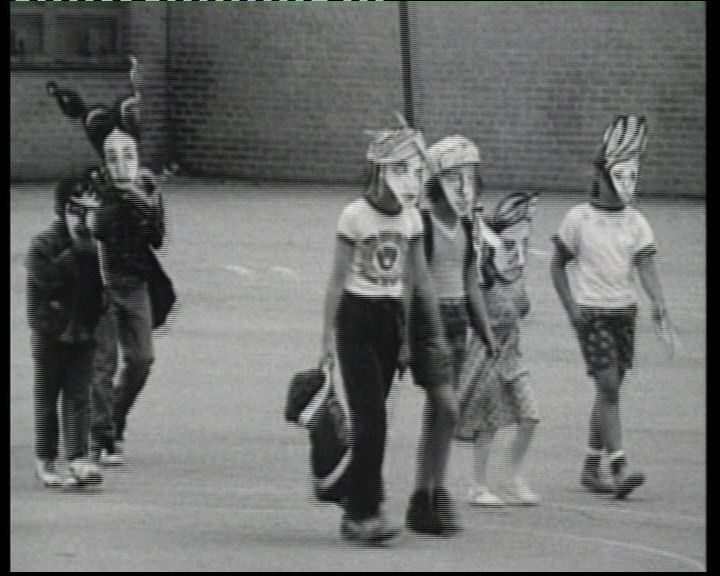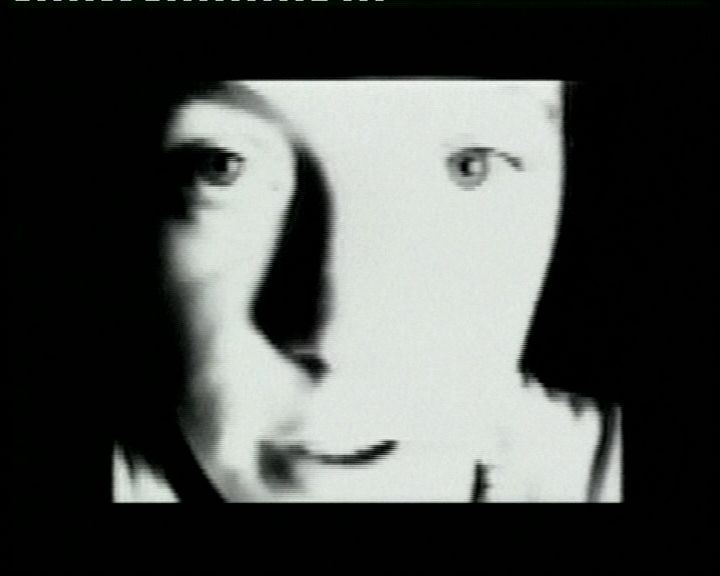Sadie Benning
Sadie Benning has been making videos since the age of fifteen. Initially, she primarily used the Fisher Price Pixelvision video camera she received from her father, the experimental filmmaker James Benning. Right from the start, she showed unique and precocious talent. Starting with the most intimate sphere of her own experience and the most immediate physical universe of her camera, Benning elaborated a series of works that are linked to a glorious tradition of experimental cinema and video narrated in the first person, though offering new and intense testimonies of female and lesbian observation and reflection.
In fact, all of Benning’s work began and continued from a fervent process of re-evaluation of personal daily experiences. Her audiovisual productions are centered around growth experiences, on both an internal level and in relation to society, with all its limits, conditioning processes, and unpleasant moments. Desires, fears, and fantasies are added to the process of confrontation, the social and sexual development one would expect from a young woman conforming to so-called norms. Instead, the various forms of rebellion and transgression—as they are evoked in many of her videos—indicate the need for a different identity beyond heterosexual conventions. Benning demonstrates a unique talent in making use of and transforming images appropriated from various sources, ranging from television to newspapers, magazines, and many other situations tied to forms of mass culture. The artist reconsiders these images through her own sensibility. Often somewhere between an almost seductive ability and a somewhat disarming honesty, Benning’s narrations make use of objects, fragments of writing, and (above all in her first works) her constant looking into the camera. Along with extreme close-ups and shots that almost seem to fly and float, her works carry the spectators into a universe of intimate and evocative revelations.
With humor and frankness, but also with disillusion or sadness, the complex personality of the young artist has revealed itself, year after year, work after work, not only accompanying the viewer through different existential situations, but also in phases of self-awareness and maturing. In recent years, Benning has progressively grown interested in using third person narration, creating personal reinterpretations of animation techniques and 16 mm cinema. [FB]
List of works
A New Year, 1989
video, black and white, sound, 6 min.
Castello di Rivoli Museo d’Arte Contemporanea, Rivoli-Torino
Purchased with the contribution of the Compagnia di San Paolo
In a flow of video footage of TV entertainment programs and radio sounds, the work shows the sharp contrast between the intolerance—almost existential exasperation—of the artist and her contact with the outside world, as it is filtered in the particular and topical moment of a New Year’s Day.
Living Inside, 1989
video, black and white, sound, 6 min.
Castello di Rivoli Museo d’Arte Contemporanea, Rivoli-Torino
Purchased with the contribution of the Compagnia di San Paolo
A sort of self-portrait, consisting in extreme close-ups with her off-screen voice, the video describes a phase of reflection on the part of the artist who, after moments of nervous dissatisfaction, decides to return to work.
Me and Rubyfruit, 1989–90
video, black and white, sound, 5 min. 30 sec.
Castello di Rivoli Museo d’Arte Contemporanea, Rivoli-Torino
Purchased with the contribution of the Compagnia di San Paolo
Images of a doll accompany the voice of the artist who follows a series of considerations regarding the problematic condition of girls and the difficulty of an openly homosexual relationship, combined with a sense of inadequacy and distress with consolidated social expectations.
If Every Girl Had a Diary, 1990
video, black and white, sound, 9 min.
Castello di Rivoli Museo d’Arte Contemporanea, Rivoli-Torino
Purchased with the contribution of the Compagnia di San Paolo
Scenes of strongly contrasting interiors alternate with the artist’s eyes. Benning talks about herself, describing and comparing her life to what is commonly defined as an alternative lifestyle. Comparisons to her own life, as how it was lived in the past, are coupled with the present. The video records details of the room where the girl lives and has decided to film.
Jollies, 1990
video, black and white, sound, 11 min.
Castello di Rivoli Museo d’Arte Contemporanea, Rivoli-Torino
Purchased with the contribution of the Compagnia di San Paolo.
Marked at the beginning by the presence of two naked dolls, the video narrates, to the pace of the artist’s hushed voice, the essential stages of her first sexual curiosities and shy contacts. More intimate moments alternate, up until the final scene where the artist enacts the typically male rituals of shaving and knotting a tie.
A Place Called Lovely, 1991
video, black and white, sound, 14 min.
Castello di Rivoli Museo d’Arte Contemporanea, Rivoli-Torino
Purchased with the contribution of the Compagnia di San Paolo
Benning talks, in the first person, about a series of situations of discomfort and uneasiness: physical violence, deceit, fear, and forms of social inequality and injustice, as found and experienced in daily reality, on the streets or in a bus. While the video camera lingers on the details of a diary, little toy cars, TV film scenes, and tabloid-like headlines are shown as elements and clues of a crime scene. In a close analysis of her past, Benning, though confessing she was bullied and hurt, refuses to remain a mere victim.
It Wasn’t Love, 1992
video, black and white, sound, 20 min.
Castello di Rivoli Museo d’Arte Contemporanea, Rivoli-Torino
Purchased with the contribution of the Compagnia di San Paolo
In a fragmentary story, although characterized by a subtle humor that is not immediately evident, Benning shows us various poses—almost stereotypes—of specific figures of masculinity and femininity: from the rebel to the vamp, the biker to the naive girl. In between, she talks about an adventure with an “easy girl” on the Hollywood hills. As the story gradually unfolds, Benning addresses herself directly to the spectators, taking great care of the visuals and sound: in fact, every excerpt of music represents a comment, as well as a specific mood.
Girl Power, 1992
video, black and white, sound, 15 min.
Castello di Rivoli Museo d’Arte Contemporanea, Rivoli-Torino
Purchased with the contribution of the Compagnia di San Paolo
The video begins with a series of considerations regarding the need for the artist to create an imaginary world of her own—a place, a situation to believe and relive in. Benning narrates the former need to impersonate the winning models of young, successful men, who are always ready to take care of girls. Then she describes the gradual process of transformation through which a girl can once again win back confidence in the female presence within society thanks to models represented by some female rock stars (such as Joan Jett, Debbie Harry, and the Go-Go’s).
German Song, 1995
transferred from Super 8 film, black & white, sound, 5 min.
Castello di Rivoli Museo d’Arte Contemporanea, Rivoli-Torino
Purchased with the contribution of the Compagnia di San Paolo
In a series of shootings in desolate places, Benning offers us an image of separated, almost lost, youth, accompanied by the music of the group Come. The work is filmed in an evocative and atmospheric Super 8.
The Judy Spots, 1995
video, black and white, sound, 15 min.
Castello di Rivoli Museo d’Arte Contemporanea, Rivoli-Torino
Purchased with the contribution of the Compagnia di San Paolo
In a series of short animated episodes, based on papier mâché characters (who remind us of the traditional Punch and Judy), this work shows us Judy’s daily life, a girl who tries to establish herself in various ways, confronting a growing feeling of isolation and estrangement. Verbally animated, she does not lack ability to analyze the world that surrounds her (for example, when she works at a fast food restaurant or when she visits a large mall). She seems to be able to fulfill her dreams only when she is playing with her band.
Flat Is Beautiful, 1998
video, black and white, sound, 50 min.
Castello di Rivoli Museo d’Arte Contemporanea, Rivoli-Torino
Purchased with the contribution of the Compagnia di San Paolo
In this complex narration, the actors wear large paper masks over their faces. The situations are described minimally, with brief dialogues and seem frozen by a slow tone. Taylor, an eleven-year-old girl, lives with her mother—lonely and separated—in an apartment shared with a young gay man called Quiggy. The father exists only on the phone and is always complaining and physically distant. Taylor feels attracted to other girls, but at the same time she feels confused, always left alone in front of the TV screen where she spends her days playing video games. Her mother goes from periods of frustration, due to bulimia, to encounters with new partners, who do not seem to interest her a great deal, except for spending a little time together. Taylor seeks comfort by asking advice from Quiggy, but he is uncomfortable playing the father figure.
Filmed in video (Pixelvision), together with Super 8 film and cartoons, the work is solidly structured by a seemingly hopeless scenario. The figure of the solitary, lonely girl convincingly represents all the difficulties and uncertainties of growing up in a hostile and desolate world.









